Comparative Investigation for Rotten Xylem (kuqin) and Strip Types (tiaoqin) of Scutellaria baicalensis Georgi Based on Fingerprinting and Chemical Pattern Recognition
Abstract
1. Introduction
2. Results
2.1. Similarity Evaluation
2.2. HCA Modeling
2.3. PCA Modeling
2.4. PLS-DA Modeling
2.5. Determination of Baicalin, Baicalein, and Wogonoside
3. Experimental
3.1. Materials and Reagents
3.2. Sample Preparation
3.3. Chromatographic Analysis
3.4. Chemical Pattern Recognition
3.5. Software Requirements
4. Conclusions
Author Contributions
Funding
Conflicts of Interest
Abbreviations
References
- Chinese Pharmacopoeia Committee. Pharmacopoeia of the People’s Republic of China; Chemical Industry Press: Beijing, China, 2015; pp. 301–302. [Google Scholar]
- Seo, O.N.; Kim, G.-S.; Kim, Y.-H.; Park, S.; Jeong, S.W.; Lee, S.J.; Jin, J.S.; Shin, S.C. Determination of polyphenol components of Korean Scutellaria baicalensis, Georgi using liquid chromatography–tandem mass spectrometry: Contribution to overall antioxidant activity. J. Funct. Foods 2013, 5, 1741–1750. [Google Scholar] [CrossRef]
- Li, H.B.; Jiang, Y.; Chen, F. Separation methods used for Scutellaria baicalensis active components. J. Chromatogr. B 2004, 812, 277–290. [Google Scholar] [CrossRef]
- Wang, Y.F.; Ting, L.I.; Tang, Z.H.; Chen, X.P.; Wang, Y.T.; Lu, J.J. Progress on chemical composition and pharmacological activities of Scutellariae Radix. Chin. Arch. Tradit. Chin. Med. 2015, 23, 206–211. [Google Scholar]
- Yan, B.; Xu, W.; Su, S.; Zhu, S.; Zhu, Z.; Zeng, H.; Zhao, M.; Qian, D.; Duan, J.-A.; Duan, J. Comparative analysis of 15 chemical constituents in Scutellaria baicalensis stem-leaf from different regions in China by ultra-high performance liquid chromatography with triple quadrupole tandem mass spectrometry. J. Sep. Sci. 2017, 40, 3570–3581. [Google Scholar] [CrossRef] [PubMed]
- Olennikov, D.N.; Chirikova, N.K.; Tankhaeva, L.M. Phenolic compounds of Scutellaria baicalensis Georgi. Russ. J. Bioorg. Chem. 2010, 36, 816–824. [Google Scholar] [CrossRef]
- Lu, Y.; Joerger, R.; Wu, C. Study of the chemical composition and antimicrobial activities of ethanolic extracts from roots of Scutellaria baicalensis Georgi. J. Agric. Food Chem. 2011, 59, 10934–10942. [Google Scholar] [CrossRef]
- Horvath, C.R.; Martos, P.A.; Saxena, P.K. Identification and quantification of eight flavones in root and shoot tissues of the medicinal plant Huang-qin (Scutellaria baicalensis Georgi) using high-performance liquid chromatography with diode array and mass spectrometric detection. J. Chromatogr. A 2005, 1062, 199–207. [Google Scholar] [CrossRef]
- Liu, X.; Liu, C. Baicalin ameliorates chronic unpredictable mild stress-induced depressive behavior: Involving the inhibition of NLRP3 inflammasome activation in rat prefrontal cortex. Int. Immunopharmacol. 2017, 48, 30–34. [Google Scholar] [CrossRef]
- Li, Y.; Zhao, J.; Hölscher, C. Therapeutic potential of baicalein in Alzheimer’s disease and Parkinson’s disease. CNS Drugs 2017, 31, 639–652. [Google Scholar] [CrossRef]
- Hong, M.; Cheng, H.; Song, L.; Wang, W.; Wang, Q.; Xu, D.; Xing, W. Wogonin suppresses the activity of matrix metalloproteinase-9 and inhibits migration and invasion in human hepatocellular carcinoma. Molecules 2018, 23, 384. [Google Scholar] [CrossRef]
- Shi, L.; Hao, Z.; Zhang, S.; Wei, M.; Lu, B.; Wang, Z.; Ji, L. Baicalein and baicalin alleviate acetaminophen-induced liver injury by activating Nrf2 antioxidative pathway: The involvement of ERK1/2 and PKC. Biochem. Pharmacol. 2018, 150, 9–23. [Google Scholar] [CrossRef] [PubMed]
- Wang, Q.Q.; Xu, H.O.; Zhao, X.F. Baicalin inhibits human cervical cancer cells by suppressing protein kinase C/signal transducer and activator of transcription (PKC/STAT3) signaling pathway. Med. Sci. Monit. 2018, 24, 1955–1961. [Google Scholar] [CrossRef] [PubMed]
- Dinda, B.; Dinda, S.; Dassharma, S.; Banik, R.; Chakraborty, A.; Dinda, M. Therapeutic potentials of baicalin and its aglycone, baicalein against inflammatory disorders. Eur. J. Med. Chem. 2017, 131, 68–80. [Google Scholar] [CrossRef] [PubMed]
- Gąsiorowski, K.; Lamer-Zarawska, E.; Leszek, J.; Parvathaneni, K.; Yendluri, B.B.; Blach-Olszewska, Z.; Aliev, G. Flavones from Root of Scutellaria Baicalensis Georgi: Drugs of the Future in Neurodegeneration? CNS Neurol. Disord. Drug Targets 2011, 10, 184–191. [Google Scholar] [CrossRef] [PubMed]
- Wang, D.; Jiang, Y.; Liang, Y.; Zhao, L.; Cai, S.; Shang, M.; Yuan, P.; Zhao, Y.; Wang, X. Research on relationship between commercial specifications of Scutellariae Radix and chemical composition and drug quality. Chin. J. Chin. Mater. Med. 2012, 37, 426–433. (In Chinese) [Google Scholar]
- Li, X.D.; Cheng, L.P.; Zhang, L.H.; Gu, X.Z.; Mao, S.J. Comparison of effective components content from different grade radix scutellariae with xylem rotten and strip type radix scutellariae. Chin. J. Inf. Tradit. Chin. Med. 2013, 2013, 55–59. (In Chinese) [Google Scholar]
- Prabhu, K.; Karar, P.K.; Ponnudurai, K.; Hemalatha, S. Pharmacognostic investigation of the leaves and stems of Viburnum erubescens Wall. ex DC. Trop. J. Pharm. Res. 2010, 8, 557–566. [Google Scholar] [CrossRef][Green Version]
- Zhang, L.; Shi, J.; Tang, J.; Cheng, Z.; Lu, X.; Kong, Y.; Wu, T. Direct coupling of thin-layer chromatography–bioautography with electrostatic field induced spray ionization–mass spectrometry for separation and identification of lipase inhibitors in lotus leaves. Anal. Chim. Acta 2017, 967, 52–58. [Google Scholar] [CrossRef]
- Tang, Z.; Qin, J.; Xu, X.; Shi, G.; Yang, H.; Liang, Y. Applying silica gel column chromatography to purify resveratrol from extracts of Morus alba L. leaf. J. Med. Plants Res. 2011, 5, 3020–3027. [Google Scholar]
- Shi, M.; Sun, G. Integrated evaluation of HPLC and UV fingerprints for the quality control of Danshen tablet by systematic quantified fingerprint method combined with antioxidant activity. J. Sep. Sci. 2017, 40, 1942–1952. [Google Scholar] [CrossRef]
- Wang, S.; Xu, Y.; Wang, Y.; Lv, Z.; Cui, Q.; Jin, X.; Wang, Y. HPLC fingerprint combined with quantitation of main effective components and chemometrics as an efficient method for quality evaluation of oviductus ranae. Nat. Prod. Commun. 2017, 12, 1495–1499. [Google Scholar] [CrossRef]
- Gong, D.; Hong, Y.; Sun, G.; Zhang, J. Novel strategy for quality consistency evaluation of Chinese medicine “YIQING” tablet that combines the simultaneous quantification and screening of ten bioactive constituents. J. Sep. Sci. 2017, 40, 3064. [Google Scholar] [CrossRef] [PubMed]
- Kong, W.J.; Zhao, Y.L.; Xiao, X.H.; Jin, C.; Li, Z.L. Quantitative and chemical fingerprint analysis for quality control of Rhizoma Coptidischinensis based on UPLC-PAD combined with chemometrics methods. Phytomedicine 2009, 16, 950–959. [Google Scholar] [CrossRef]
- Zhuang, H.; Ni, Y.; Kokot, S. Combining HPLC-DAD and ICP-MS data for improved analysis of complex samples: Classification of the root samples from Cortex moutan. Chemom. Intell. Lab. Syst. 2014, 135, 183–191. [Google Scholar] [CrossRef]
- Lucio-Gutiãrrez, J.R.; Coello, J.; Maspoch, S. Enhanced chromatographic fingerprinting of herb materials by multi-wavelength selection and chemometrics. Anal. Chim. Acta 2012, 710, 40–49. [Google Scholar] [CrossRef]
- Ciosek, P.; Brzózka, Z.; Wróblewski, W.; Martinelli, E.; Di Natale, C.; D’amico, A. Direct and two-stage data analysis procedures based on PCA, PLS-DA and ANN for ISE-based electronic tongue—Effect of supervised feature extraction. Talanta 2005, 67, 590–596. [Google Scholar] [CrossRef]
- Zhou, X.; Tang, L.; Wu, H.; Zhou, G.; Wang, T.; Kou, Z.; Li, S.; Wang, Z. Chemometric analyses for the characterization of raw and processed seeds of Descurainia sophia (L.) based on HPLC fingerprints. J. Pharm. Biomed. Anal. 2015, 111, 1–6. [Google Scholar] [CrossRef]
- Liu, W.D.; Yan, L.G.; Fang, Y.; Liu, M.S. Utility of UPLC-ESI-TOF/MS for Rapid Analysis of the Constituents in Scutellariae Radix. Inf. Tradit. Chin. Med. 2012, 29, 20–24. [Google Scholar]
Sample Availability: Not available. |
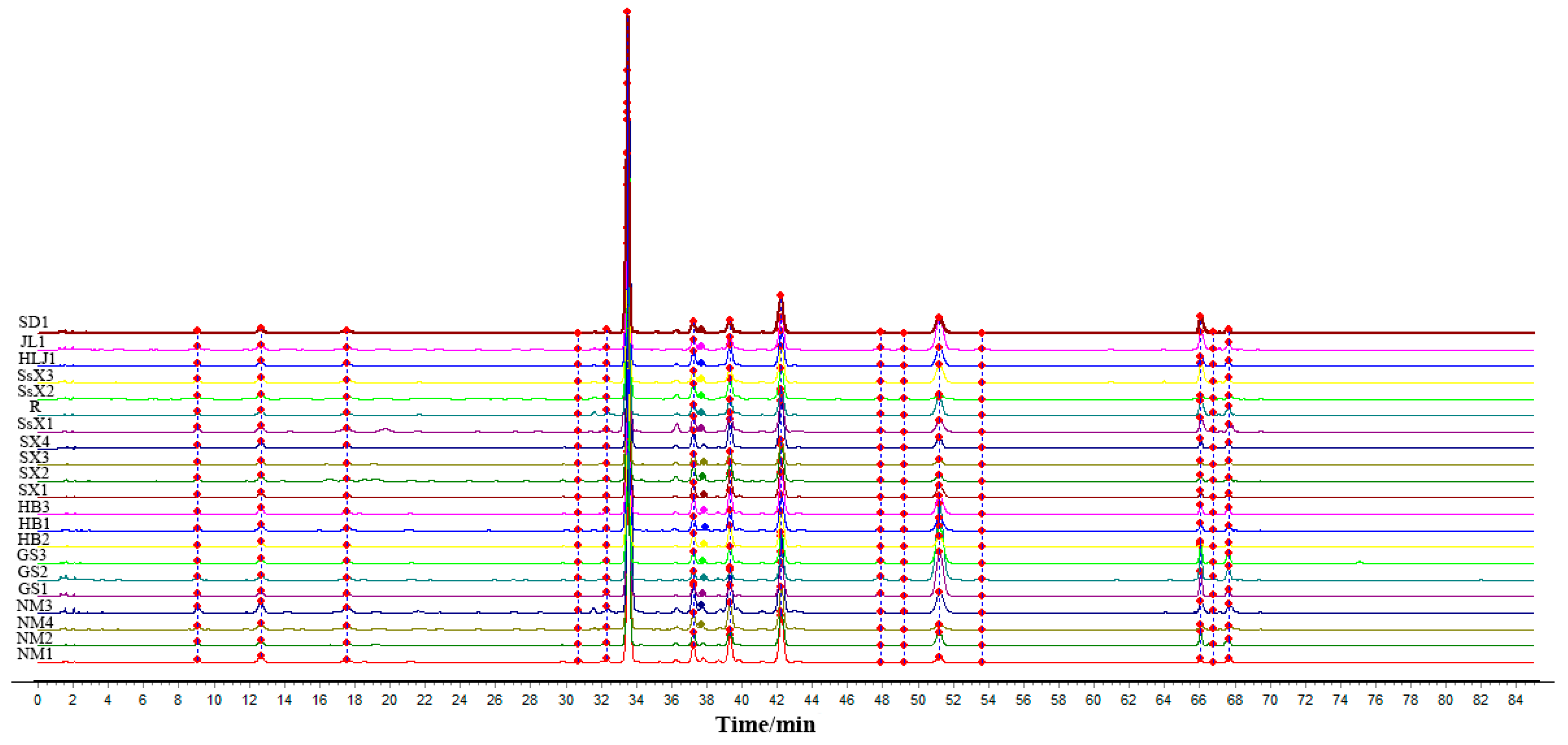
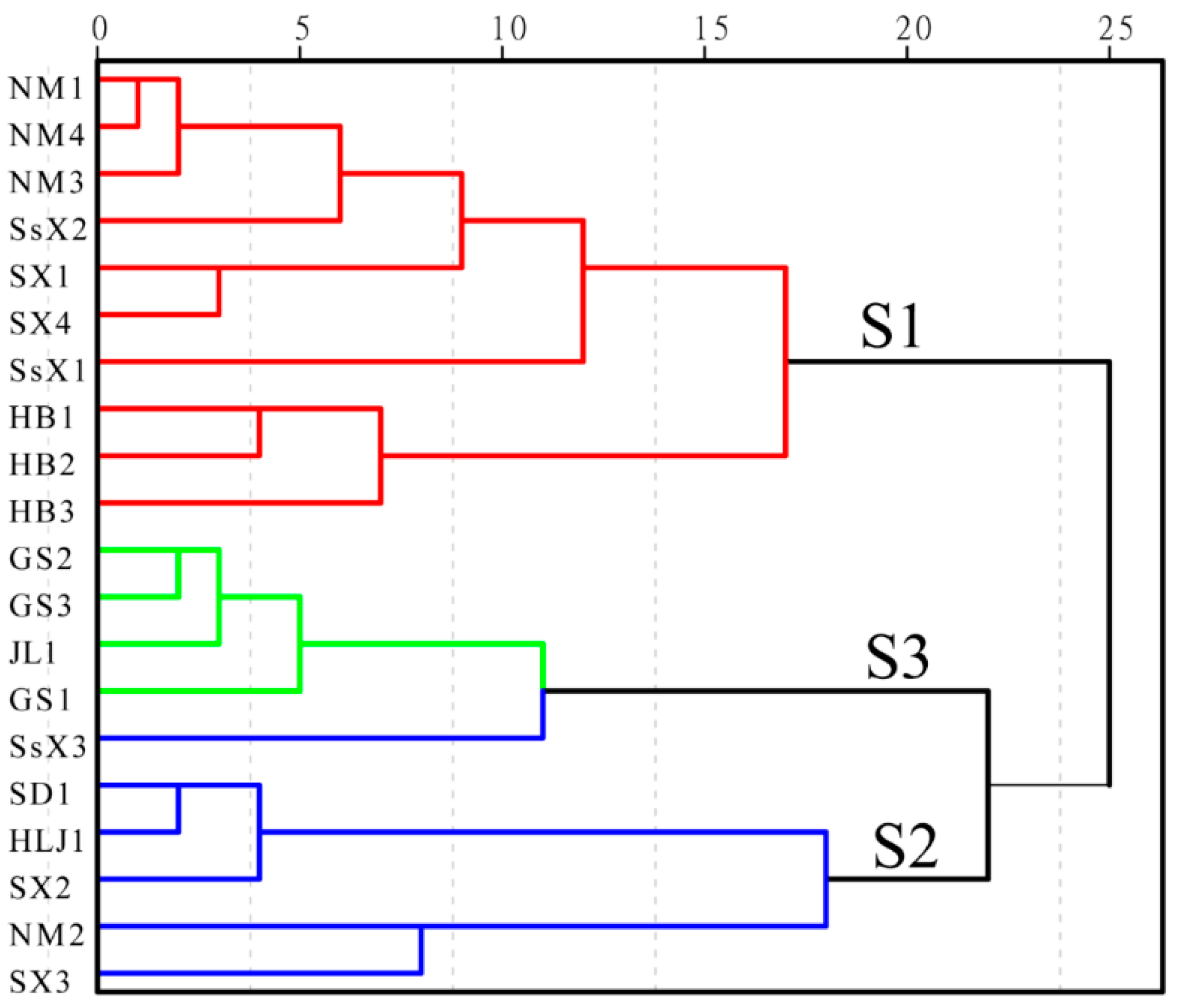
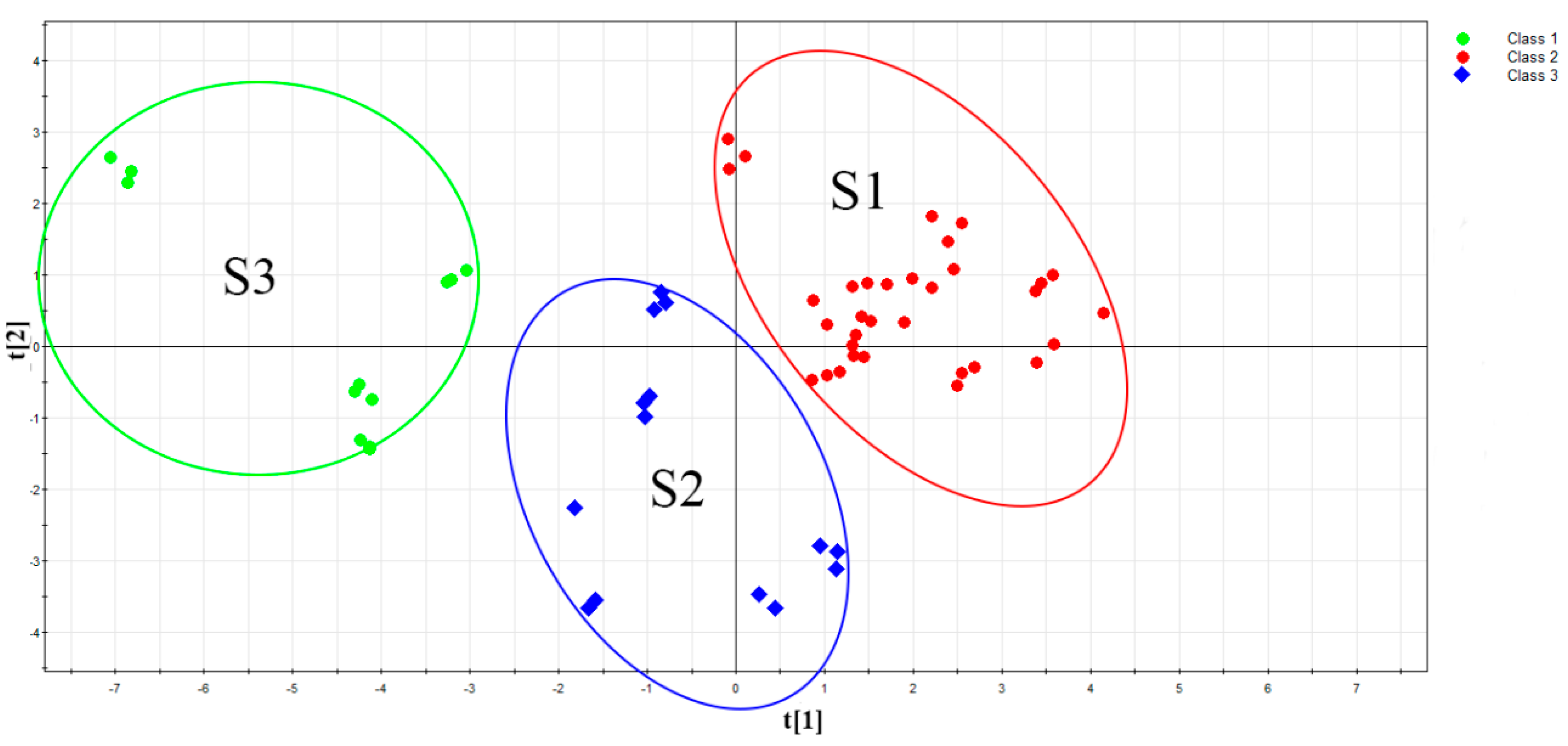
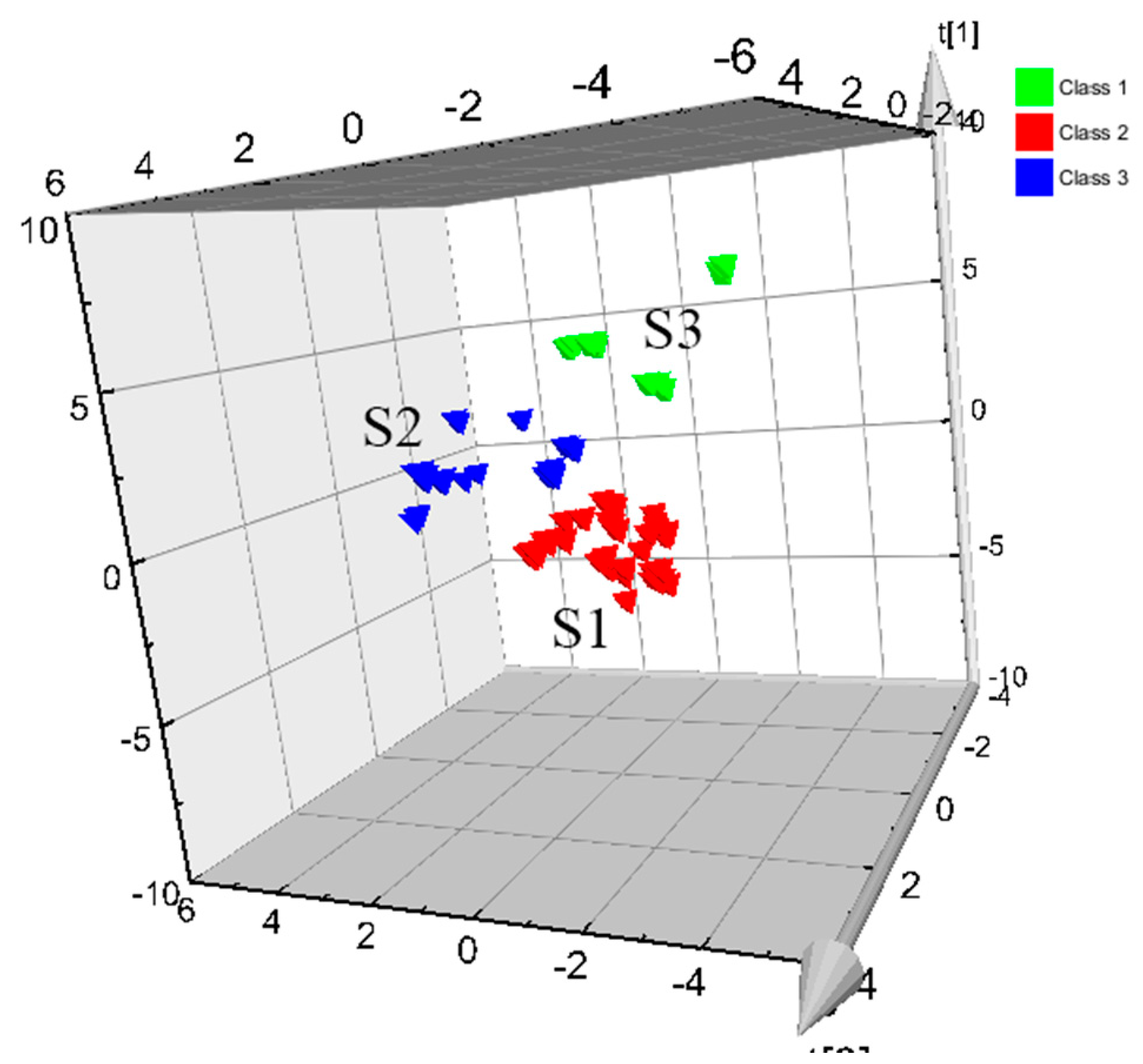


| Batch | Similarity | Batch | Similarity |
|---|---|---|---|
| NM1 | 0.992 | SX2 | 0.994 |
| NM2 | 0.998 | SX3 | 0.997 |
| NM4 | 0.993 | SX4 | 0.995 |
| NM3 | 0.997 | SSX1 | 0.997 |
| GS1 | 0.961 | SSX2 | 0.990 |
| GS2 | 0.777 | SSX3 | 0.999 |
| GS3 | 0.975 | HLJ1 | 1.000 |
| HB2 | 0.998 | JL1 | 0.982 |
| HB1 | 0.999 | SD1 | 0.999 |
| HB3 | 1.000 | SX1 | 0.998 |
| No. | T/min | [M + H]+ (m/z) | Formula | Error (ppm) | Typical Fragment Ions (MS2) m/z | Identification | Proposed Structure |
|---|---|---|---|---|---|---|---|
| 1 | 2.230 | 548.7 | C26H28O13 | 0.5 | 531/513/495/392/374.6 | Chrysin-6-C-arabinose-8-C-glucoside |  |
| 2 | 2.551 | 548.7 | C26H28O13 | 0 | 531/513/495/392/374.6 | Chrysin-6-C-glucoside-8-C-arabinose | 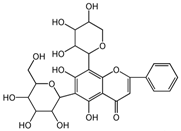 |
| 5 | 3.954 | 462.4 | C22H20O11 | 0 | 286.3 | Oroxylin A-7-O-glucuronide |  |
| 7 | 6.341 | 446.6 | C21H18O11 | -0.6 | 270.5/252.8 | Baicalin |  |
| 8 | 8.132 | 446.6 | C21H18O11 | -0.7 | 270.5 | Baicalin isomer | - |
| 9 | 8.938 | 460.6 | C22H20O11 | 0 | 284.6 | Wogonoside isomer | - |
| 10 | 10.049 | 460.6 | C22H20O11 | 0.6 | 284.5 | Wogonoside |  |
| 12 | 14.548 | 270.5 | C15H10O5 | -0.3 | 253.2 | Baicalein |  |
| Batch | Baicalin (%) | Baicalein (%) | Wogonoside (%) |
|---|---|---|---|
| JL1 | 9.00 | 2.12 | 2.01 |
| NM1 | 11.57 | 2.77 | 0.33 |
| NM2 | 6.60 | 2.03 | 0.79 |
| NM3 | 10.25 | 2.00 | 0.51 |
| NM4 | 11.74 | 2.51 | 0.34 |
| SD1 | 10.39 | 2.32 | 0.94 |
| GS1 | 6.98 | 1.98 | 2.38 |
| GS2 | 5.37 | 1.58 | 3.91 |
| GS3 | 9.11 | 1.84 | 2.10 |
| HB1 | 10.92 | 2.45 | 0.81 |
| HB2 | 10.39 | 2.55 | 0.76 |
| HB3 | 9.02 | 2.47 | 1.09 |
| SX1 | 9.75 | 2.17 | 0.68 |
| SX2 | 9.45 | 1.98 | 0.36 |
| SX3 | 9.95 | 2.11 | 0.51 |
| SX4 | 12.36 | 2.45 | 0.56 |
| HLJ1 | 10.18 | 2.41 | 1.23 |
| SsX1 | 10.44 | 2.40 | 0.66 |
| SsX2 | 10.99 | 2.00 | 0.30 |
| SsX3 | 10.07 | 2.36 | 1.08 |
| Sample Name | Origin | Origin Code | Source |
|---|---|---|---|
| GS11-GS12-GS13-GS21-GS22-GS23 GS31-GS32-GS33 | Gansu | GS | SBG |
| NM11-NM12-NM13-NM21-NM22-NM23 NM31-NM32-NM33-NM41-NM42-NM43 | Neimeng | NM | SBG |
| JL11-JL12-JL13 | Jilin | JL | SBG |
| HLJ11-HLJ12-HLJ13 | Heilong jiang | HLJ | SBG |
| SX11-SX12-SX13-SX21-SX22-SX23 SX31-SX32-SX33-SX41-SX42-SX43 | Shanxi | SX | SBG |
| SsX11-SsX12-SsX13-SsX21-SsX22-SsX23 SsX31-SsX32-SsX33 | Shaanxi | SsX | SBG |
| HB11-HB12-HB13-HB21-HB22-HB23 HB31-HB32-HB33 | Hebei | HB | SBG |
| SD11-SD12-SD13 | Shandong | SD | SBG |
© 2019 by the authors. Licensee MDPI, Basel, Switzerland. This article is an open access article distributed under the terms and conditions of the Creative Commons Attribution (CC BY) license (http://creativecommons.org/licenses/by/4.0/).
Share and Cite
Cao, X.; You, G.; Li, H.; Li, D.; Wang, M.; Ren, X. Comparative Investigation for Rotten Xylem (kuqin) and Strip Types (tiaoqin) of Scutellaria baicalensis Georgi Based on Fingerprinting and Chemical Pattern Recognition. Molecules 2019, 24, 2431. https://doi.org/10.3390/molecules24132431
Cao X, You G, Li H, Li D, Wang M, Ren X. Comparative Investigation for Rotten Xylem (kuqin) and Strip Types (tiaoqin) of Scutellaria baicalensis Georgi Based on Fingerprinting and Chemical Pattern Recognition. Molecules. 2019; 24(13):2431. https://doi.org/10.3390/molecules24132431
Chicago/Turabian StyleCao, Xuexiao, Guangjiao You, Huanhuan Li, Di Li, Meng Wang, and Xiaoliang Ren. 2019. "Comparative Investigation for Rotten Xylem (kuqin) and Strip Types (tiaoqin) of Scutellaria baicalensis Georgi Based on Fingerprinting and Chemical Pattern Recognition" Molecules 24, no. 13: 2431. https://doi.org/10.3390/molecules24132431
APA StyleCao, X., You, G., Li, H., Li, D., Wang, M., & Ren, X. (2019). Comparative Investigation for Rotten Xylem (kuqin) and Strip Types (tiaoqin) of Scutellaria baicalensis Georgi Based on Fingerprinting and Chemical Pattern Recognition. Molecules, 24(13), 2431. https://doi.org/10.3390/molecules24132431






